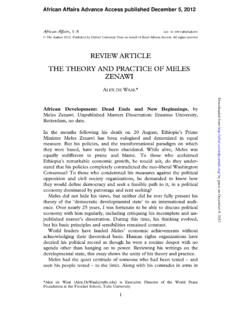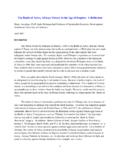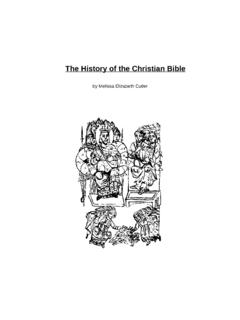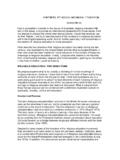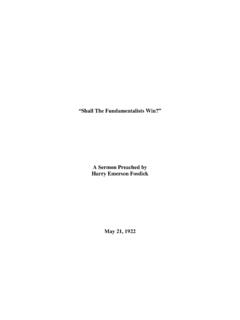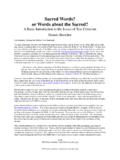Transcription of The Ethiopian Orthodox Tewahedo Church: History, …
1 1 The Ethiopian Orthodox Tewahedo church : history , Doctrine, and Challenges Ghelawdewos Araia, PhD November 20, 2017 : Psalm 68:31 Given the present challenges the Ethiopian Orthodox Tewahedo church (henceforth EOTC) has encountered, this article intends to critically examine the internal and external foes of the church and expose the agent provocateur mission to emasculate and if possible destroy the EOTC, and I will do so by way of discussing the history , doctrine, and challenges of the church . However, at the outset, I like to make my position clear that I happen to be a scholar and a professor but not literati in theology; in fact, admittedly, my knowledge of theology is minimal and negligible, to say the least.
2 Moreover, I would like to make it clear that I will not apologize to anyone for defending the EOTC, and it is for the following reasons: 1) The Ethiopian Orthodox Tewahedo Orthodox church is an embodiment of moral and ethical teachings as well as values rooted in solid Ethiopian mores and traditions; 2) the church has massively and greatly contributed to the material and Intellectual facets of the Ethiopian civilization; 3) the church has consistently and without wavering stood against all enemies of Ethiopia by sending Tabot (replica of the Ark of the Covenant) to war fronts and in some instances by sacrificing its own leaders while vociferously advocating for Ethiopian sovereignty and independence.
3 Furthermore, it should also be clear to my readers that I would equally advocate on behalf of other Ethiopian religions such as Islam, Catholicism, and Protestantism if they are ridiculed and attacked. I am not a pious Orthodox in the strict sense of the term but I happen to be a member of the EOTC and I have great admiration and respect to the tenets, teachings, and festivals of the church , and I have no doubt in my mind that my sentiment is shared by the fifty six million Tewahedo adherents collectively known as Me emenan ( believers/mass congregation). The EOTC is not only a religious institution and a faith order, but it is also a kernel of culture and history ; it is indeed inextricably linked together to the ancient and medieval 2 history of Ethiopia and remains to this day in symbolizing and representing what its followers identify with.
4 For this apparent reason, thus, the EOTC plays a pivotal role in the life and psychological makeup of the Me emenan and the latter embrace their church and jealously guard it against all detractors. Brief Historical Synopsis of the Ethiopian Orthodox Tewahedo church The EOTC is one of the oldest Christian churches in the world, and as a result Ethiopia was known as the oldest Christian Kingdom in spite of the fact that there are also other faiths in Ethiopia other than Christianity. However, given the different accounts and perspectives of historians, the advent of Christianity in Ethiopia and the beginnings of the church are subject to interpretation and controversy.
5 Most Ethiopians in the 1960s, 1970s, 1980s, and beyond have taken it for granted, and I might add without being critical, that Christianity in Ethiopia was anchored following Ezana, the first Christian king, in the first half of the 4th century. Some historians have a slightly different view and attribute the coming of Christianity to Ethiopia to one Ethiopian eunuch, a treasurer for Queen Hendake (aka Gersamot and/or Candace), while sojourning in Jerusalem met Philip the Evangelist (not the Apostle) and he was subsequently baptized by him. Thus, the argument continues, the treasurer of Queen Hendake was the first Christian convert, and after he returned to his homeland Ethiopia, he, in turn, undertook the mission of converting other Ethiopians to Christianity.
6 One other version of the history of Christianity in Ethiopia is also associated with St. Matthew, one of the twelve Apostles, or one of the four Evangelists according to Christian tradition, preached in Ethiopia and died in Ethiopia in 74 Common Era (CE) and it is highly probable that St. Matthew baptized a significant number of Ethiopians before he died. Now, if we put together the story of the treasurer of Queen Hendake and that of St. Matthew s preaching in Ethiopia, there is only a distance of two decades between the Queen s end of her reign (50 or 52 CE) and the death of the Evangelist.
7 In the first two decades of the first century CE, thus, some Christian sects had established themselves in present-day Tigray Regional State of Ethiopia, and it seems to me that this argument is more convincing, viable, and plausible. 3 Therefore, depending on plausible historical accounts and logical inferences, we can with confidence assert that there were Christians in Ethiopia three centuries before Ezana became Christian. There is no doubt that that Emperor Ezana (320-360) was the first Christian king of Ethiopia but we don t have any credible evidence that mass baptism followed the king s conversion to Christianity, but there is no doubt that those Christian Ethiopians, who for the most part conducted their prayers underground, now came out to the public square without fear and intimidation.
8 This was a great historical event in Ethiopian history because after Ezana embraced Christianity, the latter faith became official religion of Ethiopia and the first Ethiopian church was established and for the last one thousand and seven hundred years, the church occupied a center stage position in the annals of Ethiopian history . On top of the above backdrop on the advent of Christianity in Ethiopia, it is important to acknowledge the harbingers of official Christianity and the establishment of the incipient Ethiopian church . According to legend and some documentary evidence, two young brothers by the name Frumentius and Aedasius, whose ship wrecked on the Red Sea, were brought to the court of Ezana, and later the elder Frumentius (known as Freminatos in Ethiopia) became the first bishop of the first Ethiopian church in Askum after he was consecrated by Pope Athanasius in 328 CE.
9 Apparently, Athanasius was the protagonist who argued against Arius at the Council of Nicaea in 325 CE; only three years after Nicaea, thus, the new Ethiopian Christian Tewahedo church was founded as followers of Athanasius and ever since the church was headed by an Egyptian bishop until it became autocephalous. The EOTC further consolidated after the Council of Chalcedon in 451 CE and the coming of the nine saints to Ethiopia around 480 CE. Most of these saints came from Syria and other neighboring countries then ruled by the Byzantine Roman Empire of late antiquity; in some oral history and narrative with respect to the saints they are often confused as Romans due to Roman hegemony but most of them are of Western Asia or what we call today middle eastern origins; they were anti-Chalcedon and they were persecuted by the powers-that-be of the Roman Empire, fled their respective countries and found sanctuary in Ethiopia.
10 Indeed, they were well received by the Christian king Kaleb (Ella Atsbeha) and soon after they began to acclimatize the Ethiopian environment; they began 4 learning Geez and studying the local culture as well as finding monasteries as shown below: Name of Saint Place of Monastery Abba Pentelewon Aksum Abba Liqanos Aksum Abba Aregawi (aka Ze-Michael) Debre Damo Abba Afse Yeha Abba Guba Mudama Abba Gerima (aka Ishaq) Adwa Abba Tsehma Sedenya Abba Yam ata Gere alta Abba Alef Bi isa (at Mereb River) Doctrine of the Ethiopian Orthodox Tewahedo church (EOTC) The faith and teachings of the EOTC emanates from the Judea-Christian tradition by which the church accepted the Old Testament (generally referred to as Orit in Ethiopia)

